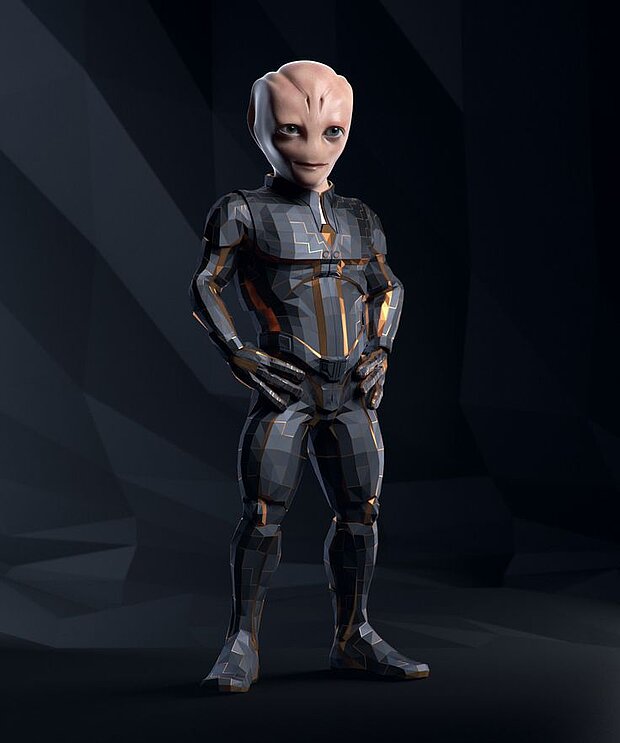
Job profile Virtual Design
The Virtual Designer
The potential job market for graduates is very dynamic. Numerous start-ups in the field of information and communication technologies are targeting a rapidly growing market. This mainly concerns network technologies and the Internet. The increasing digitalization of film, video and television, such as virtual studios in all television stations, also leads to a high demand for appropriately trained specialists.
The professional fields of activity are extremely diverse and in some cases include job profiles that are developing or in a constant process of change.
In our opinion, a concept of interdisciplinary expansion of the term "media" also applies here:
The anchoring of teaching content in architectural education was described by various experts interviewed as particularly innovative and forward-looking.
While there has already been a corresponding differentiation of training occupations in vocational training, academic institutions have been rather slow to respond to the new challenges.
The Kaiserslautern University of Applied Sciences is convinced that the qualification profile imparted in the Virtual Design course is attractive for a wide range of professional fields:
Virtual simulations in all areas of architecture, interior design and product design, virtual stage design (set design in TV and theater), e-commerce (e.g. virtual department stores), education and science (e.g. computer-based learning; simulations), culture (museums, libraries), liberal arts.
The range of potential employers or clients is correspondingly broad:
- Architecture, Interior Design, Product Design
- Trade show and exhibit design
- Business, Industry, Advertising
- Video-, game- and film production, animation, VFX
- Cultural and Media Education, Museums
- Scientific & Cultural Institutions
- Freelance media designers
The introduction of the new course has been very well received by many sides, first of all by the economy, which needs qualified employees in the multimedia sector, then of course by science, because there are exciting new questions to be solved, and also by politics, which wants to strengthen Kaiserslautern as a media location.
Initial situation
The field of new media and the world of experience it conveys, the so-called virtual reality, is increasingly shaping our conception and perception of the world. Aspects of the real, built reality are already being partially absorbed into the virtual realm (e.g. e-commerce).
The design of Internet sites will change fundamentally in the near future. Future web design will no longer be two-dimensional and static, but three-dimensional and moving.
There will be animations, three-dimensional objects and free movement in space.
Future web design will require a theatrical performance that requires both a mastery of Euclidean, architectural space and the ability to translate it into media. However, the design of (architectural) space is part of the mission and core competencies of architecture and interior design.
Virtual space is the continuation of real space in the world of new media.
While the architecture course deals with the design of real spaces, the interior design course deals with the design of staged spaces. It is obvious that a course of study should be added that focuses on the design of virtual spaces.
The inventor of virtual worlds can no longer define himself as a technical specialist for a specific medium, but must become a cross-media generalist. Know-how from all areas of electronic media will flow into a new spearhead for media design.
The starting point and basis of the discussion, however, is the architectural and creative understanding of the (virtual, artificial) space of the new media. In addition to the necessary conceptual and creative definition of an initially abstract medium, this also means a sense of responsibility for the design of the visually and physically tangible, artificial environment.
The term "Virtual Design" stands for this symbiosis. The new course combines the existing design skills of architecture, interior design and product design with the possibilities of the new media.
Course Content
Virtual Design is an interdisciplinary course that combines the existing design skills of architecture, interior design and product design with the possibilities of new media.
The bachelor's program is a condensed undergraduate program: In the first year, students are expected to take comprehensive introductory courses to learn how to apply and creatively use the technologies to be developed in the context of exercises and projects.
In the second and third years, there are individual opportunities for personal specialization and interdisciplinary cooperation within the framework of module projects.
Competencies
The project study program aims to promote sustainable, interdisciplinary key qualifications that are essential for the media sector: Analytical and abstract thinking, creativity, methodology, team spirit and critical self-awareness.
In addition to professional qualifications, soft skills are a key criterion for professional aptitude, both during studies and in later professional life.
Project work and practical experience are examples of forms of learning in which the ability to work in a team and all aspects of communication are experienced in one's own actions. Communicative and decidedly person-oriented forms of education seem to us to be particularly important, especially in a screen-oriented way of working.
An interdisciplinary project course with artistic design and highly complex technical content means that very intensive individual supervision of the students by the teaching staff is an absolute necessity.
The so-called forum, which runs like a red thread through the entire course with 2 SWS per semester, also serves to promote interdisciplinary skills:
- Deepening the public discussion at the university about the perspectives, goals and projects of the program.
- Discussions with experts on current trends in (international) professional and artistic practice.